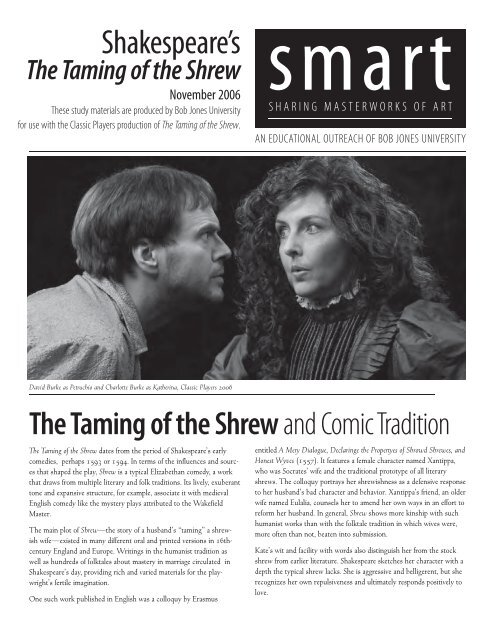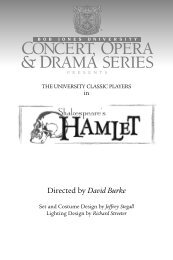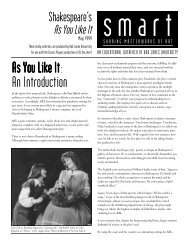Shakespeare's - Bob Jones University
Shakespeare's - Bob Jones University
Shakespeare's - Bob Jones University
Create successful ePaper yourself
Turn your PDF publications into a flip-book with our unique Google optimized e-Paper software.
Shakespeare’s<br />
The Taming of the Shrew<br />
November 2006<br />
These study materials are produced by <strong>Bob</strong> <strong>Jones</strong> <strong>University</strong><br />
for use with the Classic Players production of The Taming of the Shrew.<br />
s m a r t<br />
S H A R I N G M A S T E R W O R K S O F A R T<br />
AN EDUCATIONAL OUTREACH OF BOB JONES UNIVERSITY<br />
David Burke as Petruchio and Charlotte Burke as Katherina, Classic Players 2006<br />
The Taming of the Shrew and Comic Tradition<br />
The Taming of the Shrew dates from the period of Shakespeare’s early<br />
comedies, perhaps 1593 or 1594. In terms of the influences and sources<br />
that shaped the play, Shrew is a typical Elizabethan comedy, a work<br />
that draws from multiple literary and folk traditions. Its lively, exuberant<br />
tone and expansive structure, for example, associate it with medieval<br />
English comedy like the mystery plays attributed to the Wakefield<br />
Master.<br />
The main plot of Shrew—the story of a husband’s “taming” a shrewish<br />
wife—existed in many different oral and printed versions in 16thcentury<br />
England and Europe. Writings in the humanist tradition as<br />
well as hundreds of folktales about mastery in marriage circulated in<br />
Shakespeare’s day, providing rich and varied materials for the playwright’s<br />
fertile imagination.<br />
One such work published in English was a colloquy by Erasmus<br />
entitled A Mery Dialogue, Declaringe the Propertyes of Shrowd Shrewes, and<br />
Honest Wyves (1557). It features a female character named Xantippa,<br />
who was Socrates’ wife and the traditional prototype of all literary<br />
shrews. The colloquy portrays her shrewishness as a defensive response<br />
to her husband’s bad character and behavior. Xantippa’s friend, an older<br />
wife named Eulalia, counsels her to amend her own ways in an effort to<br />
reform her husband. In general, Shrew shows more kinship with such<br />
humanist works than with the folktale tradition in which wives were,<br />
more often than not, beaten into submission.<br />
Kate’s wit and facility with words also distinguish her from the stock<br />
shrew from earlier literature. Shakespeare sketches her character with a<br />
depth the typical shrew lacks. She is aggressive and belligerent, but she<br />
recognizes her own repulsiveness and ultimately responds positively to<br />
love.
Shakespeare is, in fact, unique among writers of his own age in eliminating<br />
physical abuse from the husband’s repertory of wife-taming techniques.<br />
In Shrew no character directs violence against the shrewish Katherina. It<br />
is she who assaults Bianca and Petruchio. The only other violence in the<br />
play occurs in the form of slapstick directed by masters against their servants<br />
in the humorous manner of Roman comedy.<br />
In the words of Richard Hosley, “Petruchio ‘tames’ Kate not by beating<br />
her but by bringing her to an awareness of her shrewishness and thus<br />
inducing her to mend her ways.”<br />
The only literary source Shakespeare is known to have drawn from directly<br />
for Shrew is George Gascoigne’s English play entitled Supposes (1566),<br />
an adaptation of Ariosto’s Italian comedy I Suppositi (1509), which has<br />
its roots in both the Roman comedy of Plautus and Terence and the<br />
Greek comedy of Menander. Echoes of Supposes appear in many details of<br />
Shakespeare’s subplot, the story of gentle Bianca and the suitors who compete<br />
for her hand in marriage. The subplot also bears the marks of a more<br />
academic sort of romantic comedy played by amateurs during the Italian<br />
Renaissance.<br />
of old fathers; and three different types of comic servants (Tranio<br />
the blunt and clever zanni, Grumio the harlequin or buffoon, and<br />
Biondello the bungling clown).<br />
Shakespeare’s early comedies are, like Shrew, more robust in tone<br />
than his later comedies. The early comedy The Comedy of Errors and<br />
the late comedy Twelfth Night exemplify this contrast. The early<br />
comedies also incorporate more elements of “low” comedy than the<br />
late ones. In Shrew Shakespeare incorporates coarse wit, horseplay,<br />
slapstick, jokes, gags and clowning. But he offers audiences intellectual<br />
humor as well as low comedy.<br />
Shakespeare derived ideas for the plot and characters of Shrew from<br />
multiple sources and traditions, yet he blends them together in<br />
brilliant unity. With its well-developed characters in the main plot<br />
of Petruchio and Kate, the elaborate interplay and thematic unity<br />
between the main plot and subplot, and its thoughtfully unfolded<br />
themes, The Taming of the Shrew is a remarkable achievement from<br />
the young playwright William Shakespeare.<br />
The element of intrigue in the subplot—underhanded scheming by rivals<br />
for Bianca’s love—is derived from Italian Renaissance commedia dellarte,<br />
a type of drama frequently performed by Italian traveling troupes in<br />
England during the 1570s and 1580s. Among the stock characters from<br />
commedia who appear in the cast are a beautiful young woman who is<br />
sought after by many men (Bianca); the young man she loves (Lucentio);<br />
a rich, foolish old man who pursues her (Gremio the pantalone); a pair<br />
“The woman is not reckoned the more worshipful among men<br />
when she presumes to have mastery over her husband: but the<br />
more foolish and the more worthy to be mocked: yea and more<br />
than that, cursed and unhappy: the which turneth backward the<br />
laws of nature, like as though a soldier would rule his captain or<br />
the moon would stand above the sun or the arm above the head.<br />
For in wedlock the man resembleth the reason, and the woman<br />
the body. Now reason ought to rule and the body to obey if a<br />
man will live. Also saint Paul sayeth, ‘The head of the woman is<br />
the man.’<br />
. . . But on the other part, if you [a wife] by virtuous living and<br />
[compliance] give [your husband] cause to love thee, thou shalt<br />
be mistress in a merry house, thou shalt rejoice, thou shalt be<br />
glad, thou shalt bless the day when thou were married unto<br />
him, and all them that were helping thereunto. The wise sentence<br />
sayeth: A good woman by lowly obeisance ruleth her husband.<br />
—Juan Luis Vives,<br />
A Very Fruitful and Pleasant Book Called the Instruction of a Christian<br />
Woman, trans. Richard Hyrde, c. 1529<br />
Laura Pratt as Katherina, Classic Players 1951
Although Shakespeare did not set out to make this point in The Taming<br />
of the Shrew, he does take for granted as a normative backdrop to the<br />
play the prevailing view of marriage as taught by the Elizabethan<br />
church. Shakespeare’s audiences would have been well familiar with this<br />
view from the homilies, catechism and prayer book of the Church of<br />
England, which includes the text of the marriage service. In the play’s<br />
final scene Kate clearly states the orthodox view of marriage. She identifies<br />
the husband as the head of a family, its protector and provider. She<br />
refers to his authority over the wife as natural and reasonable, given the<br />
physical differences between men and women. She suggests that women<br />
who do not willingly follow their husband’s leadership are foolish.<br />
With its emphasis on love and submission, the view of marriage taught<br />
by the church stood in stark contrast to the growing tendency in a<br />
mercantile world to see marriageable women as marketable commodities.<br />
After Petruchio and Baptista have discussed Kate’s dowry, Baptista<br />
David Burke as Petruchio and Charlotte Burke as Katherina, Classic Players 2006<br />
Love’s Labour’s Won: Mastery in<br />
Marriage in The Taming of the Shrew<br />
In a 1598 listing of Shakespeare’s works, Francis Meres includes among<br />
the comedies the titles Love’s Labour’s Lost and Love’s Labour’s Won.<br />
Since Meres’ list does not mention The Taming of the Shrew, some scholars<br />
have suggested that Love’s Labour’s Won was an early title for Shrew.<br />
Certainly the contrasting comic endings of Love’s Labour’s Lost and The<br />
Taming of the Shrew might suggest that these two plays generally believed<br />
to date from the same period of Shakespeare’s writing could at one time<br />
have been considered companion plays.<br />
Audiences in the early 21st century are so far removed from assumptions<br />
about marriage and the family in Shakespeare’s day that they may<br />
view The Taming of the Shrew as a defense of a man’s right to tyrannize<br />
over his wife. But the traditional view of the Church of England, based<br />
on the teachings of the New Testament, is that a wife should submit<br />
her will to her husband’s leadership. The husband’s God-given duty, as<br />
stated by the apostle Paul in Ephesians 5, is, by most estimates, an even<br />
taller order than the wife’s: he must put aside all self-interests to love<br />
and care for his wife as Christ did for His bride, the Church. By this<br />
standard neither husband nor wife was liberated in the modern sense<br />
of the word in Shakespeare’s day. Instead, the two were bound together<br />
by love and solemn mutual responsibilities. Both were called upon to<br />
submit.<br />
Classic Players 1990<br />
cautions Petruchio that the match will not be valid until “the special<br />
thing is well obtain’d” by Petruchio, “That is, her love; for that is all in<br />
all” (II.i.128-29). Baptista not only guards against giving Kate to a mere<br />
fortune hunter; in a positive sense he recognizes love as the basis of a<br />
happy marriage and emotional stability as more important than financial<br />
security.<br />
Having gotten the father’s approval to court Kate, Petruchio sets out to<br />
woo and win her, quickly formulating a set of motives and methods that
Katherina<br />
Bianca<br />
baptista<br />
Classic Players 2006<br />
Baptista Minola, His Daughters<br />
and Their Suitors<br />
Petruchio<br />
Lucentio<br />
allow him to “tame the shrew.” At the couple’s first meeting Petruchio<br />
learns just how high-spirited Kate is as she verbally attacks every person<br />
and premise that come her way. Unlike her father and sister, Petruchio<br />
is not intimidated by Kate’s fury or threats of violence against him. He<br />
not only holds his own in their witty sparring; he also manages to apply<br />
a sort of reverse psychology to their relationship. After every fiery outburst<br />
of anger from Kate, Petruchio commends her for being a beautiful,<br />
sensible, kind and quiet woman.<br />
Another principle of Petruchio’s strategy is that he never allows Kate to<br />
have the loudest or last word. When she behaves boisterously against<br />
him, Petruchio throws tantrums even louder than hers. In fact, he exaggerates<br />
every feature of her shrewish behavior as a means of showing<br />
her just how repugnant she appears to other people. He also reveals<br />
to Kate the shallowness of certain values she shares with her society,<br />
including her attachment to fashion.<br />
Thus Petruchio and Kate progress from one stage of the taming process<br />
to the next, enduring varying degrees of discomfort together, until<br />
Kate clearly demonstrates that Petruchio’s “reverend care of her” has<br />
realized its goal of her own positive development. Petruchio and Kate<br />
have at last come to a tacit agreement about the unprofitability of her<br />
“The direction of the play, for Katherine and Petruchio, is towards marriage as a rich,<br />
shared sanity. That means asserting and sharing all the facts about one’s identity, not<br />
suppressing large areas. . . . If [Kate] is a true Shakespearian heroine, in marriage she<br />
becomes herself only more so… Marriage is addition, not subtraction: it is a sad letdown<br />
if the dazzling action of the play produces only a female wimp. But at the end<br />
of the play she shows that she shares with Petruchio an understood frame for both<br />
their lives. . . . Her final step is when she shows to Petruchio that they, the two of<br />
them, can contain violence and rebellion in their own mutual frame.”<br />
—David Daniell, “The Good Marriage of Kate and Petruchio”<br />
Betty Panosian as Katherina and Edward Panosian as Petruchio, Classic Players 1961
<strong>Bob</strong> <strong>Jones</strong> III as Petruchio, Stephen <strong>Jones</strong> as Tranio and Steve Eager as Hortensio, Classic Players 1990<br />
perverse behavior, and she abandons it altogether in favor of spirited obedience to<br />
Petruchio’s demands. Love’s labors have been won. In the words of Anne Barton,<br />
“What Petruchio wants, and ends up with, is a Katherina of unbroken spirit and<br />
gaiety who has suffered only minor discomfort and who has learned the value of<br />
self-control and caring about someone other than herself.”<br />
Commenting on the relationship of Petruchio and Kate as husband and wife,<br />
Germaine Greer refers to Kate’s final speech on the respective duties of marriage<br />
partners “the greatest defense of Christian monogamy ever written.” Whether or<br />
not audiences appreciate the premises about marriage that Shakespeare appropriates<br />
and Kate gives authoritative voice to in The Taming of the Shrew, the play remains a<br />
popular piece of stage entertainment because of its witty treatment of a perennially<br />
favorite subject—mastery in marriage.<br />
These materials are original and ©2006, <strong>Bob</strong> <strong>Jones</strong> <strong>University</strong>, Dr. Janie Caves<br />
McCauley, writer. All rights reserved. No part of this study guide may be reproduced<br />
or transmitted in any form or by any means, electronic, mechanical, photocopying,<br />
recording or otherwise, without the prior written permission of the publisher.<br />
Petruchio<br />
Petruchio “thrust[s] upon himself the rude selfwill<br />
which actually belongs to [Kate], so that<br />
she beholds what she now is in his mirror, and<br />
he (to quote his man Peter) ‘kills her in her own<br />
humor.’ [He also] thrust[s] on her the semblance<br />
of a modest, well-conducted young woman . . . so<br />
that she beholds in another mirror what she may<br />
become if she tries. . . . Petruchio’s stratagem . . .<br />
reflects love’s genuine creative power, which can<br />
on occasion make the loved one grow to match<br />
the dream.”<br />
—Maynard Mack,<br />
“Engagement and Detachment in Shakespeare’s Plays”<br />
“The direction of the play, for Katherine and Petruchio, is towards marriage as<br />
a rich, shared sanity. That means asserting and sharing all the facts about one’s<br />
identity, not suppressing large areas. . . . If [Kate] is a true Shakespearian heroine,<br />
in marriage she becomes herself only more so. . . . Marriage is addition,<br />
not subtraction: it is a sad let-down if the dazzling action of the play produces<br />
only a female wimp. But at the end of the play she shows that she shares with<br />
Petruchio an understood frame for both their lives. . . . Her fi nal step is when she<br />
shows to Petruchio that they, the two of them, can contain violence and rebellion<br />
in their own mutual frame.”<br />
—David Daniell, “The Good Marriage of Kate and Petruchio”<br />
Katherina
Lewis suggests that courtly love conventions became the basis of modern<br />
courtship etiquette in which the woman always takes precedence<br />
over the man. He is the one who initiates social activity with her, but<br />
she determines the direction the relationship will take. Further, Lewis<br />
traces the modern notion that “happiness [is] grounded on successful<br />
romantic love” to courtly love tradition.<br />
Shakespeare alludes to courtly love conventions in both his tragedies<br />
and his comedies, including The Two Gentlemen of Verona, The Taming<br />
of the Shrew, Love’s Labour’s Lost, A Midsummer Night’s Dream, Much<br />
Ado about Nothing and Antony and Cleopatra. In general he portrays the<br />
courtly lover as the ultimate fool, for even if he succeeds in winning the<br />
hand of the woman he pursues, misery is his lot.<br />
In The Taming of the Shrew, Lucentio becomes the typical courtly lover<br />
after falling in love at first sight with Bianca. He describes himself as<br />
one who pines, cries and suffers miserably from the pangs of love. He<br />
extols the object of his love, Bianca, in conventional poetic terms as a<br />
goddess with coral lips and perfumed breath. In short, he tells Tranio,<br />
“Sacred and sweet was all I saw in her.” He declares that if he fails to<br />
win her love, he will “perish.” Shakespeare always makes light of such<br />
romantic excess.<br />
Christi Woodruff as Bianca and Philip Eoute as Lucentio, Classic Players 2006<br />
Romantic Excess Onstage<br />
Courtly Love in Shakespeare<br />
During the 12th-century reign of Henry II of France, Queen<br />
Eleanor of Aquitane and her daughter Marie created a court in<br />
which clerics disputed the nature of love. Andreas Capellanus,<br />
court chaplain, summarizes the “rules” that issued from this court<br />
in a treatise entitled The Art of Courtly Love. Many of the conventions<br />
he records had already been sung about by 11th-century<br />
French troubadours. Others had been incorporated in the works of<br />
the Roman poet Ovid.<br />
According to C. S. Lewis, the traditions of courtly love brought<br />
about significant changes in the way romantic love is depicted<br />
in literature and perhaps also set up new expectations for gender<br />
relationships in real life. In classical literature love is a trifle that<br />
might temporarily distract a man in the course of his heroic labors.<br />
In courtly love tradition, however, a man (the lover) becomes an<br />
abject slave, obeying every whim of the woman he loves (the mistress)<br />
to gain her favor. He serves her just as vassals in the Middle<br />
Ages served their lords and ladies. If she scorns him, he becomes<br />
physically ill.<br />
To be near Bianca, whose father has forbidden any suitors to approach<br />
her, the enraptured Lucentio exchanges clothes with his servant Tranio,<br />
remarking that he is willing to become an abject slave to win this<br />
seemingly unattainable woman. He is employed as a Latin scholar by<br />
Gremio, another suitor to Bianca, with the agreement that he will woo<br />
her for the other man. Instead, he courts Bianca for himself and reveals<br />
his love to her by interpolating a text by Ovid. Thus having won Bianca<br />
through deceit, Lucentio marries her without parental knowledge or<br />
consent.<br />
The outcome of the plot for Lucentio is not fully revealed until the closing<br />
moments of the play when Bianca’s true nature becomes apparent.<br />
For all his romantic lovesickness Lucentio has won a wife who proves<br />
the opposite of his expectations. By contrast, Petruchio, who has<br />
wooed his Kate in rough, unromantic style, takes home the real prize.<br />
Shakespeare thus illustrates the hazards of judging by outward appearance<br />
as well as the reward of deceit.<br />
Emily Anderson as Bianca, Laura Pratt as Katherina and Robert Wiebe as Baptista, Classic Players 1951<br />
The courtly love mistress takes precedence over all the lover’s<br />
other endeavors in life, even his occupation and his religion.<br />
Disdainful and unapproachable, she becomes a goddess whom the<br />
lover adores. He sends her gifts, sings to her and promises to obey<br />
and defend her forever. If after a long period of courtship, the mistress<br />
finally has mercy on the lover, they pledge to remain faithful<br />
to each other and keep their love secret.
WILLIAM SH<br />
TAMING<br />
OF<br />
Petruchio<br />
PADUA CITY, WYOM<br />
AND SOMEWHERE ALO<br />
Lucentio with his servant<br />
Tranio arrives in<br />
Padua as a student.<br />
On the street the two<br />
witness an encounter<br />
between the wealthy<br />
gentleman Baptista with<br />
his daughters Katherina<br />
and Bianca and two suitors to<br />
Bianca. Hortensio and Gremio vie<br />
for the hand of Baptista’s younger<br />
daughter in marriage. But Baptista<br />
declares that Bianca cannot wed until<br />
he has a husband for<br />
her headstrong older<br />
sister, Katherina.<br />
After Baptista and his daughters leave, Lucentio and<br />
Tranio overhear Hortensio and Gremio making plans to<br />
hire tutors for Bianca and to send her gifts in order to<br />
advance themselves favorably in her eyes and her father’s.<br />
They also agree to find a husband for Katherina.<br />
After Bianca’s suitors leave,<br />
Lucentio reveals to Tranio that<br />
he has fallen in love at first sight<br />
with Bianca. Tranio schemes to<br />
help his master gain access to<br />
her and woo her. They agree that<br />
Lucentio will take on a disguise<br />
and secure a position as tutor<br />
to Bianca while Tranio becomes<br />
“Lucentio” and makes his master’s<br />
suit for Bianca to her father.<br />
Petruchio, a swaggering gentleman from Verona,<br />
arrives in Padua looking for a rich wife. His old<br />
friend Hortensio urges him to pursue Baptista’s<br />
daughter Katherina but warns him that she is a<br />
shrew. Not to be intimidated by a woman, Petruchio<br />
agrees to speak to Baptista about Katherina<br />
immediately. When Petruchio and Kate meet, they<br />
appear to be a mismatch, but after an episode of<br />
fast, forthright talk, Petruchio sets the wedding<br />
date for Sunday.
AKESPEARE’S<br />
SHREW<br />
ING, CIRCA 1880<br />
NG THE YUKON TRAIL<br />
Katherina<br />
Posing as Lucentio, Tranio steps up the stakes with Baptista for Bianca’s<br />
hand, outbidding the wealthy old Gremio. Meanwhile Lucentio,<br />
disguised as a Latin scholar named Cambio, presses his suit directly<br />
to Bianca and wins her promise of love.<br />
Petruchio arrives late and illclothed<br />
for the wedding, which<br />
occurs offstage. Afterwards he<br />
announces that rather than staying<br />
for the wedding feast, he and<br />
Kate will leave immediately for<br />
his country house near Verona.<br />
Kate responds in fury, but Petruchio<br />
carries her off.<br />
Once at home, Petruchio makes<br />
outrageous demands of his servants<br />
and contrives for Kate to be hungry,<br />
sleepless and frustrated until he has<br />
“tamed” her. The motive for his clever<br />
strategy is love. He endures the<br />
same hardships as she and carries<br />
out his taming plan in a manner that<br />
reveals his “reverend care for her.”<br />
Later as Petruchio and Kate journey back toward Baptista’s house at<br />
Padua, Kate’s presumed progress in wifely submissiveness is put to the<br />
extreme test. Once there, the couple meet family and friends at a banquet<br />
celebrating the recent marriages of three couples: Petruchio and Kate;<br />
Lucentio and Bianca, who have eloped; and Hortensio and the Widow.<br />
Petruchio challenges Kate to give a public lecture to Bianca and Hortensio’s<br />
bride on a wife’s duties toward her husband. In the end<br />
everyone present at the banquet marvels at Petruchio’s taming of<br />
the shrew.

















